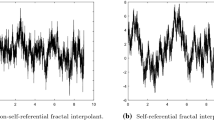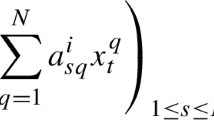Abstract
Iterated Function System (IFS) models have been used to represent discrete sequences where the attractor of the IFS is self-affine or piecewise self-affine in R 2 or R 3 (R is the set of real numbers). In this paper, the piecewise hidden-variable fractal model is extended from R 3 to R n (n is an integer greater than 3), which is called the multi-dimensional piecewise hidden variable fractal model. This new model uses a “mapping partial derivative” and a constrained inverse algorithm to identify the model parameters. The model values depend continuously on all the hidden variables. Therefore the result is very general. Moreover, the piecewise hidden-variable fractal model in tensor form is more terse than in the usual matrix form.
Similar content being viewed by others
References
Maragos, P.: Fractal aspects of speech signals: Dimension and interpolation. In: IEEE International Conference on Acoustics, Speech and Signal Processing, Canada, May 14–17, pp. 417–420 (1991)
Zhu, X., Cheng, B., Titterington, D.M.: Fractal model of a one-dimension discrete signal and its implementation. In: IEE Proceedings: Vision, Image and Signal Processing, vol. 141, pp. 318–324 (1994)
Wittenbrink, C.M.: IFS Fractal interpolation for 2D and 3D visualization. In: Proceedings of the IEEE Visualization Conference, Atlanta, October 29–31, pp. 77–84 (1995)
Zhao, N.: Construction and application fractal interpolation surfaces. Vis. Comput. 12, 132–146 (1996)
Price, J.R., Hayes, M.H.: Fractal interpolation of images and volumes. In: Conference Record of the Asilomar Conference on Signals, Systems & Computers, Pacific Grove, November 1–4, pp. 228–230 (1998)
Ida, T., Sambonsugi, Y.: Self-affine mapping system for object contour extraction. In: IEEE International Conference on Image Processing, Japan, October 24–28, pp. 250–254 (1999)
Ida, T., Sambonsugi, Y.: Self-affine mapping system and its application to object contour extraction. IEEE Trans. Image Process. 9, 1926–1936 (2000)
Nettleton, D.J.: Representation and generation of graphs using iterated function systems. Appl. Math. Lett. 10, 75–77 (1997)
Chu, H.-T., Chen, C.-C.: On bounding boxes of iterated function system attractors. Comput. Graph. 27, 407–414 (2003)
Honda, H., Haseyama, M., Kitajima, H.: Fractal interpolation for natural images. In: IEEE International Conference on Image Processing, Japan, October 24–28, pp. 657–661 (1999)
Mazel, D.S., Manson, H.H.: Using iterated function system to model discrete sequences. IEEE Trans. Signal Process. 40, 1724–1734 (1992)
Mazel, D.S.: Representation of discrete sequences with three-dimensional iterated function systems. IEEE Trans. Signal Process. 42, 3269–3271 (1994)
Mazel, D.S., Manson, H.H.: Hidden-variable fractal interpolation of discrete sequence. In: IEEE International Conference on Acoustics, Speech and Signal Processing, Canada, May 14–17, pp. 3393–3396 (1991)
Peruggia, M.: Discrete Iterated Function Systems. Wellesley, Massachusetts (1993)
Craciunescu, O.I., Das, S.K., Poulson, J.M., Samulski, T.V.: Three-dimensional tumor perfusion reconstruction using fractal interpolation functions. IEEE Trans. Biomed. Eng. 48, 462–473 (2001)
Craciunescu, O.I., Das, S.K., Wong, T.Z., Samulski, T.V.: Fractal reconstruction of breast perfusion before and after hyperthermia treatments. Bioeng. Div. (ASME) 54, 207–211 (2002)
Craciunescu, O.I., Das, S.K., Samulski, T.V.: Piecewise fractal interpolation models to reconstruct the three-dimensional tumor perfusion. In: Proceedings of the 2000 World Congress on Medical Physics and Biomedical Engineering and of the 22nd Annual International Conference of the IEEE Engineering in Medicine and Biology, Chicago, July 23–28, pp. 292–305 (2000)
Barnsle, M.F.: Hidden variable fractal interpolation functions. Soc. Ind. Appl. Math. J., Math. Ann. 20, 1218–1242 (1989)
Thuraisingham, R.A.: On multiscale entropy analysis for physiological data. Phys. A: Stat. Mech. Appl. 366(7), 323–332 (2006)
Li, X., Kapiris, P.G., Polygiannakis, J., Eftaxias, K.A., Yao, X.: Fractal spectral analysis of pre-epileptic seizures phase: in terms of criticality. J. Neural Eng. 2(2), 11–16 (2005)
Kapiris, P.G., Polygiannakis, J., Li, X., Yao, X., Eftaxias, K.A.: Similarities in precursory features in seismic shocks and epileptic seizures. Europhys. Lett. 69(4), 657–663 (2005)
Barnsley, M.F.: Fractals Everywhere. Academic, Boston (1993)
Strahle, W.C.: Turbulent combustion data analysis using fractals. Aircr. Ind. Assoc. Am. J. 29, 409–417 (1991)
Marvasti, M.A., Strahle, W.C.: Fractal geometry analysis of turbulent data. Signal Process. 41, 191–201 (1995)
Barnsley, M.F., Elton, J.H., Hardin, D.P.: Recurrent iterated function systems. Constr. Approx. 5, 3–31 (1989)
Barnsley, M.F.: Fractal functions and interpolation. Constr. Approx. 2, 303–329 (1986)
Zhang, T., Liu, J., Zhuang, Z.: Multi-dimensional self-affine fractal interpolation model in tensor form. Nonlinear Dyn. (2007, in press) doi: 10.1007/s11071-007-9259-5
Author information
Authors and Affiliations
Corresponding author
Rights and permissions
About this article
Cite this article
Zhang, T., Liu, J.L. & Zhuang, Z. Representation of discrete sequences with N-dimensional iterated function systems in tensor form. Nonlinear Dyn 52, 89–93 (2008). https://doi.org/10.1007/s11071-007-9260-z
Received:
Accepted:
Published:
Issue Date:
DOI: https://doi.org/10.1007/s11071-007-9260-z




